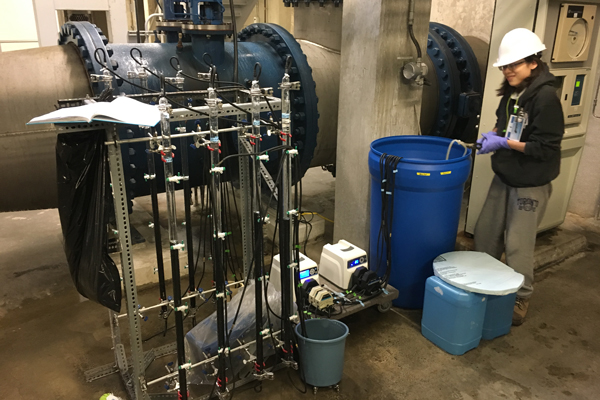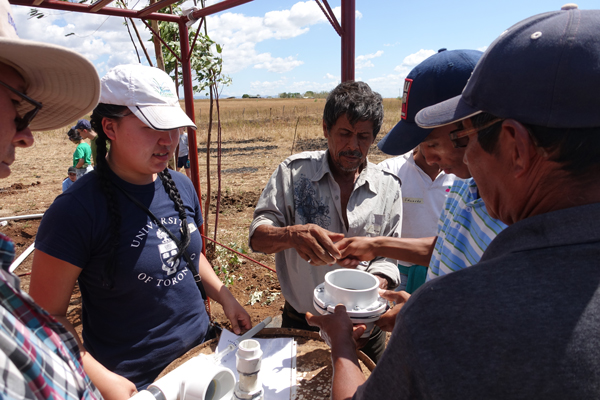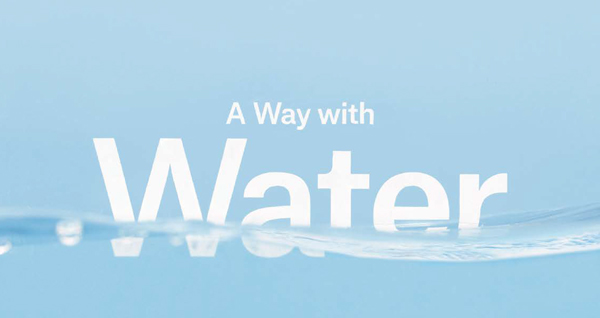Note: This piece was originally published in the 2018 issue of Skulematters magazine
Stormwater, fresh water, drinking water, industrial water: all water on Earth is part of the same cycle—and #EveryDropMatters. Around the world, water supply and quality are under increasing pressure from population growth, industrial development and climate change.
U of T Engineering researchers are leading the way in addressing these pressing global challenges. We are developing new techniques for preventing urban floods and removing contamination. We are also ensuring that drinking water and sanitation processes remain safe and cost-effective where they exist, and addressing barriers where they do not.
Through multidisciplinary research and industrial partnerships, our faculty members and students are creating solutions that will enhance our water cycle for generations to come.
Managing stormwater

It starts with just a few drops. After a minute or two it becomes a light mist, then a steady rain, then a torrent. A storm over a city the size of Toronto can empty enough water to fill more than 10,000 Olympic-sized swimming pools in less than a day.
All this water needs somewhere to go, but as most city surfaces are covered in water-impermeable concrete or asphalt, low-lying areas can flood. As the water washes over streets and sidewalks, it picks up trash, dirt, oil and chemical contaminants. The surge can quickly overwhelm the city’s wastewater treatment plants, dumping millions of litres of untreated water into Lake Ontario.
Professor Jennifer Drake (CivMin) believes there is a solution. Her research group studies green infrastructure that restores a more natural flow pattern to our built environment. These include green roofs, which can soak up water that would otherwise flood eavestroughs, as well as permeable pavement that lets floodwaters slowly infiltrate into the soil.
Drake and her team are especially interested in the long-term performance of these technologies. “Often when people build a green infrastructure system, there is a big congratulatory party, and then everyone walks away,” she says. “We want to measure whether or not it’s still working two, five or 10 years later.”
According to Drake, many of Toronto’s green roofs are irrigated with city drinking water. This keeps them looking nice and green, but it’s completely counter to the goal of buffering stormwater flows. For U of T’s newest green roof, situated atop the John H. Daniels Faculty of Architecture, Landscape and Design’s building at One Spadina, Drake and her collaborators are trying a different approach.
“One of the things that we’re investigating is the use of recycled stormwater for irrigation,” she says. “The water that discharges from the building’s green roofs will be collected in a cistern, and then returned to the green roof for irrigation.”
Other solutions they are studying include bioretention cells, also known as rain gardens. Constructed with engineered soil, these structures allow water to infiltrate into the ground while removing contaminants. Rain gardens can be added to public parks and individual homes, with the positive impact multiplying across the entire city.
“What I find so interesting about the whole stormwater world is that on the surface you think that the solution should be really simple, but the human element makes it really complicated,” she says. “Our expectations about how infrastructure should look, how much space it should take up, and the services we expect from it mean that we really need to be creative about our solutions.”
The impact of climate change is evident in water: too much, not enough, not there when we need it. We need to prepare differently for events like droughts and floods, which we can’t predict as well as we used to. Scientists and engineers need to communicate clearly about these issues with policy makers and citizens so we all understand the challenges and measures necessary to address them. — Sandra Odendahl (ChemE MASc 9T0), president and CEO of CMC Research Institutes, is an environmental sustainability and innovation leader who currently works with government and commercial stakeholders to demonstrate and scale up environmental technologies that address climate change.
Keeping our drinking water safe

Green infrastructure can help ensure that the water flowing across the city into lakes and rivers is less polluted than today. In the meantime, millions of people rely on those same bodies of water for drinking, cooking, washing, transportation and more. Safeguarding the water that comes out of your tap is the mission of the Drinking Water Research Group (DWRG).
Led by civil engineering professors Bob Andrews, Susan Andrews and Ron Hofmann, the DWRG maintains strong partnerships with manufacturers of water treatment equipment, such as General Electric Water & Process Technologies, as well as the City of Toronto and a number of other municipalities in and around the GTA.
“We look at what the emerging issues are, what’s going to be important five to ten years from now,” Hofmann says. “If someone identifies a new contaminant that might be regulated in the future, we say: here’s what you can start doing now.”
For example, most of the drugs we take—from antidepressants to birth control—pass through our bodies into wastewater. Current treatment cannot remove drug molecules, and environmental scientists are increasingly finding them downstream of urban areas. Though their concentrations in source water are still very low, regulations may soon require drinking water treatment plants to remove these molecules as part of their standard performance.
Hofmann and his collaborators are investigating the use of ultraviolet (UV) light as one solution. This kind of treatment is already used by some municipalities to disinfect drinking water, removing bacteria and other disease-causing organisms.
“To destroy these [pharmaceutical] chemicals, you have to use much higher UV doses than you would to kill microorganisms alone,” Hofmann says. “You destroy the chemicals, which is good, but you may be forming some byproducts that are also toxic. We look for those hidden dangers so municipalities can make informed decisions about new approaches.”
Another significant aspect of DWRG’s work involves testing new pieces of process equipment for municipalities. Bob Andrews recently collaborated with John Thompson, director of environmental services with the City of Barrie, to study the effectiveness of granular activated carbon beds, a type of biological filter used to remove compounds that can affect the taste and odour of drinking water.
Although the manufacturer suggests a replacement every five years, the analysis showed the beds remained effective for more than 10. The result: savings of more than $1 million over a decade. “As water managers, most of our time is taken up with the day-to-day provision of safe drinking water,” Thompson says. “This partnership gives us access to research and current knowledge, and can help us leverage the resources we have.”
From changing precipitation levels and patterns, to a water level drop in the Great Lakes Basin resulting in greater concentration of natural-occurring bacteria, there are many priorities for us to address. Innovations like those being developed by U of T’s Drinking Water Research Group are already being considered. — Liza Ballantyne (CivE MASc 9T9), senior engineer at the City of Toronto, is charged with ensuring the safety of residents’ drinking water.
Sourcing local clean water

While UV treatment and granular-activated carbon beds may be effective options for Canadian municipalities, these technologies are out of reach for many areas of the world. Professor Amy Bilton (MIE) is the associate director of the Centre for Global Engineering and runs U of T Engineering’s Water and Energy Research Lab, which aims to develop locally appropriate solutions. In Pedro Arauz, Nicaragua, a harsh dry season takes over for half of the year. Rivers evaporate, and crops and livestock can be devastated by the lack of water.
While the area has plenty of groundwater and dug wells, the use of pumps and sustainable irrigation is limited by a lack of infrastructure, high costs and difficulties importing goods.
By contrast, wind pumps can be built and maintained using local materials. In 2014 two Canadians, engineer John Shoust and management consultant Rob Scott, founded the Winds of Change initiative and began searching for a team of engineers who could take on the challenge and design a solution for the people of Pedro Arauz.
Bilton brought the project to her fourth-year capstone design course, and was inundated with applications from students who wanted to participate. Over the course of the next two years, several teams collaborated on a design that was both powerful enough to pump the required volume of water, yet simple enough to be built and repaired with locally available materials.
In January 2016, Bilton and five students worked with community members to build the wind pump out of wire, sheet metal and PVC piping in just four and a half days. “It pumped water for the first time just before we headed home, so students were really excited about that,” Bilton says.
Since then, students have continued to work with the community to improve the wind pump and implement sustainable irrigation systems to make best use of the water. Anna Jiang (MIE MASc candidate), one of Bilton’s graduate students, discovered that inefficient watering practices in the community were resulting in poor yields and water waste. To address these challenges, she developed a passive irrigation controller, a device capable of sensing how much water the soil requires and regulating the flow accordingly, all without electricity.
“I wanted to apply my engineering skills to real-life challenges that could help create global equality,” Jiang says. “Using smart scheduling to save water could help in an area like Pedro Arauz, but many of the farmers haven’t used irrigation before. This controller takes a lot of the guesswork out of the equation.”
Bilton says there is still a long way to go before the water controller can be deployed, but it has potential. “Right now, we are developing models to really understand what’s going on and then validating them experimentally,” she says. “We’ll then use these to optimize the design for particular crops and evaluate the impact of the device on crop yields and water usage. We’ll be doing consultation with the community throughout the process.”
Many developing countries are in dire need of water and sewerage systems, but setting up the necessary long-term infrastructure is much more complicated and less profitable than competing projects such as bringing in telecommunications services. Governments need to educate and hire engineers and professionals to establish and ethically enforce land use plans and title systems, which are the backbone of a sustainable infrastructure. — Serial entrepreneur and philanthropist Ron Sidon (IndE 6T6) was the primary donor and inspiration behind the Malagosi water project in central Tanzania, which serves 3,500 rural residents.
Addressing industry’s impact

As a major global player in the mining industry, Canada can have a significant impact on the way the water used in mining is managed.
“Mining uses a tremendous amount of water,” says Professor Lesley Warren (CivE), director of the Lassonde Insitute of Mining at U of T Engineering. Water is needed for processes such as flotation, which enables the separation of high-value minerals from low-value ones, and for the extraction of bitumen from oil sands. While mines recycle as much water as they can, they produce large volumes of tailings, a waste slurry made up of post-extraction, ground-up rock, chemicals and impacted water. These tailings are commonly held in on-site ponds where they have to be managed and treated.
Bacteria and other microorganisms live in tailings ponds and thrive on mineral wastes; indeed some actually ‘breathe’ rocks. However, these bacterially-driven chemical reactions can lead to environmental impacts such as acidification, toxicity and oxygen consumption. Currently, it is difficult for mines across all extractive resource industries to ensure that no impacts ever occur from their tailings ponds to the local environment because they don’t fully understand these processes.
“Mining companies know that microorganisms are driving these reactions, but it’s still a black box,” says Warren, who also holds the Claudette MacKay-Lassonde Chair in Mineral Engineering. “The lack of available technologies has meant that there has been little research to determine which bacteria are doing what, which ones could serve as early warning signals, or those that could actually be used as the biological treatment itself. Most importantly, mining companies don’t know which levers to pull to control the system.”
By studying the genes and behavior of these organisms in the lab, Warren and her collaborators are working to identify interventions that could prevent negative reactions and promote positive ones. This work involves experts in geochemistry, microbiology and genomics from Canada, the U.S. and Australia, three mining companies, and two engineering consulting firms.
“Once we understand the microbes and how they affect wastewater geochemistry, we can pinpoint the drivers of their behaviour,” Warren says. “Which wastewater compounds are they using? Do they like it hot? Do they like it cold? We can adjust those drivers to design new processes that do what we want them to do, using the bacteria that are already in these systems.”
Warren, who jokes that she has always preferred dirty water to clean, believes that recent advances in microbial genomics and other techniques have opened up many new possibilities in the field.
“So many of the organisms we’re finding are new to science,” she says. “The chances that we are going to find organisms that are capable of doing creative things that could be useful are very high.”
Increased emphasis on continuous remote monitoring of tailings impoundment areas can allow a range of conditions to be identified and managed before they become a problem. Researchers from U of T and across the country are collaborating to drive this technology forward as part of the Canadian Mining Innovation Council’s 10-year Towards Zero Waste Mining program. — Chris Twigge-Molecey (MIE MASc 6T9, PhD 7T2) is a senior advisor at Hatch and past member of the Canada Mining Innovation Council board.




